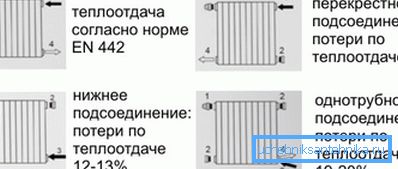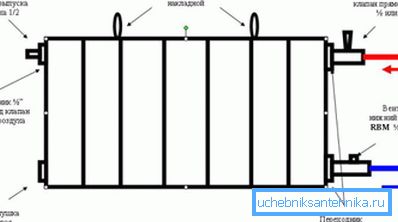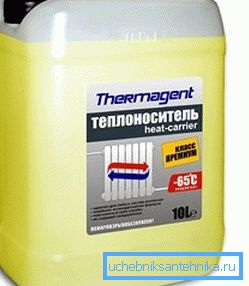The heat carrier for aluminum radiators. kinds. antifreeze,
Sometimes residents of the private sector make a very serious mistake when they install autonomous heating with aluminum radiators and do not think that in such cases ordinary water is not suitable as a heat carrier.
In addition, such a liquid is not one of a kind - there are different options and you can’t do without it, because ordinary water with its salts and alkalis will destroy aluminum, and this will certainly not suit you, so in any case you need look for a way out.

We will now tell you about the different types of such a drug, about the conditions of its use, and also invite you to view the video in this article.
Special heat carrier
What is he like at all

Note to the image. Depending on the method of supplying the fluid to the batteries, as shown in the upper image, the degree of heat transfer may change.
- The most used and demanded coolant in the whole world for water heating systems is, of course, water., but its use leads to corrosion of the metal, as well as to the formation of scale and sludge, therefore, there is a need for periodic washing and cleaning of the system. In addition, you do not have the opportunity to turn off the heating in winter, without draining the coolant, as water, of course, will freeze and what will be called “defrosting the system” - pipes and / or radiators burst - simply speaking, it goes out of service.
- From all this we can conclude that it is important not only to correctly calculate the power of the batteries for the room, but you should use a coolant that does not freeze and enters into a chemical reaction with the metal. Such special liquids have one important property that the instruction points to and you need to pay attention to it when buying - in the event of a system leakage, such a coolant does not affect the health of the human body.
Antifreeze, as a coolant
Note. Antifreeze, which literally can be translated into Russian from English, as "anti-freezing" is used to name fluids that do not freeze at low temperatures, as a general concept for such preparations. But in this case, there are special additives or additives - they serve as corrosion inhibitors and mineral deposits.

But be that as it may, when choosing antifreeze for aluminum radiators of heating, you should choose exactly the composition that is specifically designed for this purpose, since the manufacturer specifically provides all the nuances of the intended use.
But one should not look at such a coolant as some kind of panacea - it, quite naturally, has its drawbacks:
- Compared to water, its heat capacity is 115% lower;
- Without a circulation pump, it is impossible to start the system, since the antifreeze has a high viscosity and the circulation will be inhibited;
- The liquid expands strongly when heated;
- Its fluidity is 50% higher than the fluidity of water - this makes us pay special attention to welded (solder) and threaded connections;
- When using ethylene glycol antifreeze it is impossible to connect the hot water supply system, and only one circuit can be used for heating, as they are poisonous.
Ethanol based antifreeze
Note. If you are not able to purchase a sufficient number of such mixtures for a heating system with aluminum radiators, you can make them yourself, but for this you need distilled water and 40% ethanol (ethyl alcohol).

The high price of such heat carriers may not allow their use for their own autonomous system and then you will need forty percent ethyl alcohol and distilled water, which will allow you to prepare the desired liquid yourself.
It is noteworthy that such a composition is to some extent even better than the factory one, since its viscosity is much lower, but at the same time, it is in a sufficient proportion higher than that of water, and moreover, fluidity also decreases, which makes it possible to lower the requirements to a certain extent. to welded (solder) and threaded connections.
In addition, it should be noted that when using such compounds, the rubber seals (gaskets) are not damaged, which you will use in any case when installing the circuit.
Here you should also pay attention to the fact that it is best to use hard water in the manufacture of the composition - it together with ethanol does not allow the formation of scale on the inner surface of the walls of pipes and instruments.
Of course, solid sediment in this case will be necessary, but it is easily removed when flushing the system with running water. If the content of ethyl alcohol in water does not exceed the 30% barrier, alcohol evaporation will not occur - the liquid will behave exactly like regular, clean water.

Due to its identification with ordinary water, the boiling point of such a coolant is approximately at the same level with water, therefore, if the liquid heats up to 85-90 ?, then there is not a large amount of steam, as there is no boiling.
And finally, ethanol significantly reduces the thermal expansion of H2O, therefore, the risk of pipes and / or batteries rupture during a system defrost is significantly reduced.
Proportions

It should be borne in mind that a certain decrease in temperature should be accompanied by an increase in the percentage ratio of ethanol to distilled water, so if the thermometer drops to -10.6? C, then the ethanol content in the total composition should be at least 20.3%.
If the temperature drops to -23.6? C, then ethanol will require 33.8%, at a temperature of -28.7? C - 39% alcohol and at a temperature of -33.9? C - 46.3%, respectively.
But this is not all - one liter of 96% ethylene contains 960 ml of anhydrous alcohol, therefore, in order to get a 33% solution, you need to divide 96/33 = 2.9, that is, 2.9 liters of distilled water.
So, to get a 33% solution, we need one liter of ethyl alcohol and 2.9 liters of distilled water. This compound will serve as an excellent coolant for the circuit with aluminum radiators, which will not freeze even at -22.5? C.

But this composition, that is, antifreeze, the preparation of which we have described, and any other, is strictly prohibited to use in certain cases, therefore, you will have to take into account certain factors:
- The use of antifreeze in heating systems using electrolysis boilers is strictly prohibited.
- It is strictly forbidden to use antifreeze in open heating systems where ethylene glycol is used, as it is toxic.
- It is not recommended to lower the temperature beyond -20? C, as this underestimates the quality characteristics of the additives used - scum will appear on the inside of the walls.
- When using such coolants, it is not recommended to use flax tow, planted on the paint, since ethyl alcohol easily corrodes it and the connection is depressurized. For this well suited plaster paste "Unipak".
- Also in such cases it is not possible to use galvanized pipes, pipes and fittings in the system.
Conclusion
Of course, it is up to you to decide which coolant to choose for aluminum radiators, but I would like to draw attention to another feature of such circuits in combination with coolant from antifreeze.
If the working temperature of the heating system will be more than 70? C, then you better refrain from using such mixtures. The fact is that at such temperatures, thanks to alcohol, the liquid will have a very large expansion, which is unsafe for the entire system.